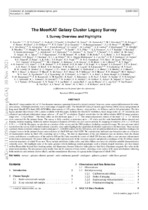| dc.contributor.author | Knowles, K | |
| dc.contributor.author | Cotton, V.D | |
| dc.contributor.author | Rudnick, L | |
| dc.date.accessioned | 2022-03-02T13:13:19Z | |
| dc.date.available | 2022-03-02T13:13:19Z | |
| dc.date.issued | 2022 | |
| dc.identifier.citation | Knowles, K., Cotton, W.D., Rudnick, L., Camilo, F., Goedhart, S., Deane, R., Ramatsoku, M., Bietenholz, M.F., Brüggen, M., Button, C. and Chen, H., 2022. The MeerKAT Galaxy Cluster Legacy Survey: I. Survey Overview and Highlights. Astronomy & Astrophysics, 657, p.A56. | en_US |
| dc.identifier.issn | 00046361 | |
| dc.identifier.uri | https://doi.org/10.1051/0004-6361/202141488 | |
| dc.identifier.uri | http://hdl.handle.net/10566/7299 | |
| dc.description.abstract | MeerKAT’s large number (64) of 13.5 m diameter antennas, spanning 8 km with a densely packed 1 km core, create a powerful instrument for wide-area surveys, with high sensitivity over a wide range of angular scales. The MeerKAT Galaxy Cluster Legacy Survey (MGCLS) is a programme of long-track MeerKAT L-band (900−1670 MHz) observations of 115 galaxy clusters, observed for ∼6−10 h each in full polarisation. The first legacy product data release (DR1), made available with this paper, includes the MeerKAT visibilities, basic image cubes at ∼8″ resolution, and enhanced spectral and polarisation image cubes at ∼8″ and 15″ resolutions. Typical sensitivities for the full-resolution MGCLS image products range from ∼3−5 μJy beam−1. The basic cubes are full-field and span 2° × 2°. The enhanced products consist of the inner 1.2° × 1.2° field of view, corrected for the primary beam. The survey is fully sensitive to structures up to ∼10′ scales, and the wide bandwidth allows spectral and Faraday rotation mapping. Relatively narrow frequency channels (209 kHz) are also used to provide H I mapping in windows of 0 < z < 0.09 and 0.19 < z < 0.48. In this paper, we provide an overview of the survey and the DR1 products, including caveats for usage. We present some initial results from the survey, both for their intrinsic scientific value and to highlight the capabilities for further exploration with these data. These include a primary-beam-corrected compact source catalogue of ∼626 000 sources for the full survey and an optical and infrared cross-matched catalogue for compact sources in the primary-beam-corrected areas of Abell 209 and Abell S295. We examine dust unbiased star-formation rates as a function of cluster-centric radius in Abell 209, extending out to 3.5 R 200. We find no dependence of the star-formation rate on distance from the cluster centre, and we observe a small excess of the radio-to-100 μm flux ratio towards the centre of Abell 209 that may reflect a ram pressure enhancement in the denser environment. We detect diffuse cluster radio emission in 62 of the surveyed systems and present a catalogue of the 99 diffuse cluster emission structures, of which 56 are new. These include mini-halos, halos, relics, and other diffuse structures for which no suitable characterisation currently exists. We highlight some of the radio galaxies that challenge current paradigms, such as trident-shaped structures, jets that remain well collimated far beyond their bending radius, and filamentary features linked to radio galaxies that likely illuminate magnetic flux tubes in the intracluster medium. We also present early results from the H I analysis of four clusters, which show a wide variety of H I mass distributions that reflect both sensitivity and intrinsic cluster effects, and the serendipitous discovery of a group in the foreground of Abell 3365. | en_US |
| dc.language.iso | en | en_US |
| dc.publisher | University of the Western Cape | en_US |
| dc.subject | Galaxy | en_US |
| dc.subject | Galaxy cluster | en_US |
| dc.subject | Radio galaxies | en_US |
| dc.subject | Cluster radio emission | en_US |
| dc.subject | Star-formation rates | en_US |
| dc.title | The MeerKAT Galaxy Cluster Legacy Survey: Survey overview and highlights | en_US |
| dc.type | Article | en_US |

